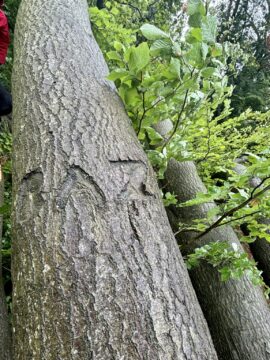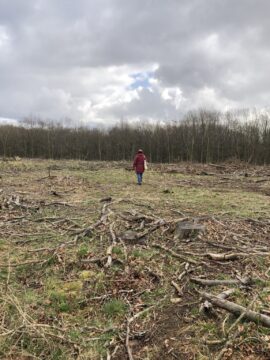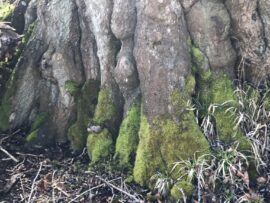In Stitches March 22nd
Some speedy slow stitching on Gary and Paul’s textile bark strips for the next Above and Below Rust and Remembrance session. Gary had no time to stitch between sessions as he’s sorting through his dear departed wife’s craft stash – an epic task. Paul could only place and pin as he has his arm strapped to his side due to injured shoulder. I sent out a message inviting participants to bring in a jar with a lid and any small, rusty items they might have for the Monday session.
24th March
We were greeted by an absolutely magnificent array of rusty chains, nails washers etc to share amongst the group but before we started group member, artist and volunteer Lillian Douglas gave a talk about her pieces, which she had dyed and dried already.Lillian had three sample pieces and was able to talk us through what had happened during each wrapping and dyeing attempt. She had many valuable insights, tips and tricks to share and held the group spellbound.
There was also a lot of “So when do you add the tea?”
“Should the tea be hot or cold?”
“Do you just drop the rusty things in with the tea?”
“What should you wrap the bundle with?’
“Oh string, has anyone got any, no, well we’ll go and buy some?”
These and other questions ran up and down the table and Lillian patiently talked everyone through the process.
There was a lot of deliberation and discussion about how many items to roll inside the bundle and how long to leave the bundle steeping before unwrapping. This form of dying is unpredictable, so much depends on whether the fabric is natural or synthetic, how tightly or loosely the bundle is wrapped, how thick the bundle is, whether you remember to allow the bundle to dry fully before unwrapping and rinsing – there is a lot of delayed gratification!
Both Lillian and I came across this dying technique when we signed up for free, 5 day workshop organised by Textile Artist.Org https://www.textileartist.org/about/ Stitch Club and led by Deb Cooper https://www.debcoopertextileart.com and when thinking about creating a symbolic tree bark effect I could see this would be engaging and have great potential when working on the digial fabrics for the floating tree columns. I made a piece out of left over scraps.
Paul brought his Mum’s sewing tin to show us, and I was reminded of my Dad’s many, many tobacco tins – same brand different designs full of useful shed things. I still have a fair few, possibly awaiting a future project, it is hard not to feel outraged by the tobacco industry, but that’s another story. Paul had dismantled and reassembled my Dad’s shed once it had been emptied, that task had fallen to Andrew and was something of an archaeological dig. We are all tied by threads that chase between our roots and branches. The bark protects us and may be where we write some part of our stories. Silver birch bark peels like paper and has such subtle colours and marks like stitches.
Sukey brought in moss from her garden and once the wrapping and chatting and clearing were done we settled down for a mythic tale from Phil!





























































